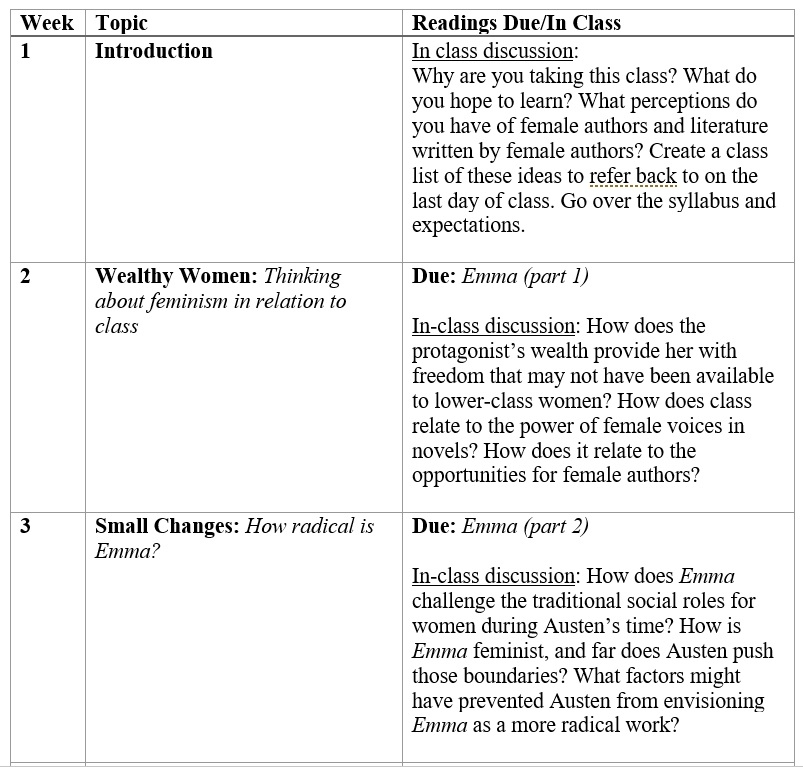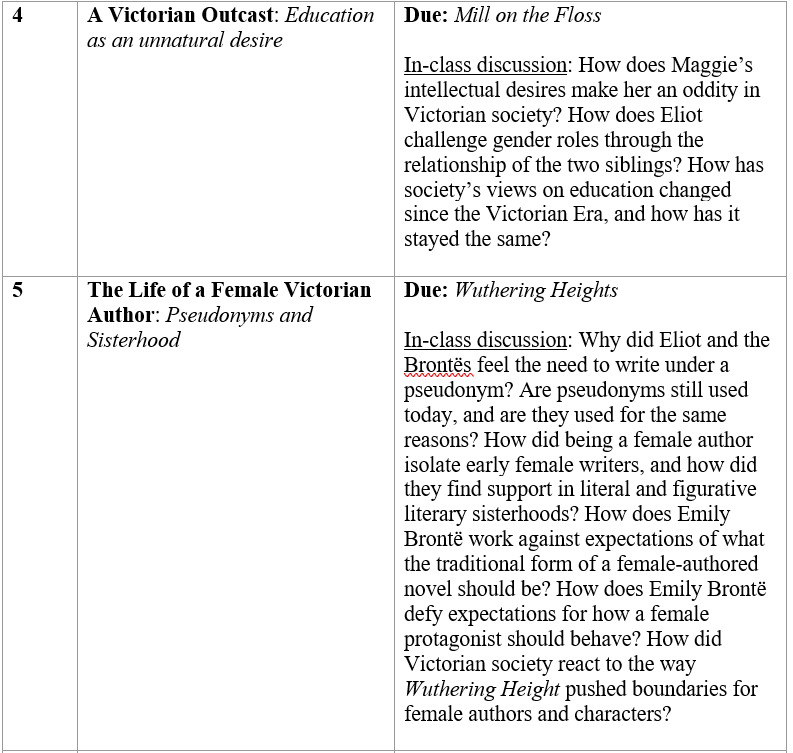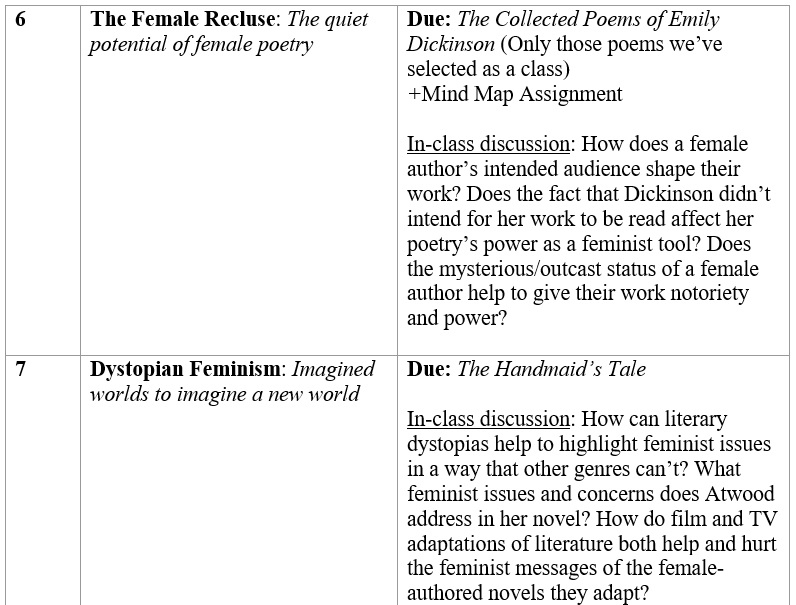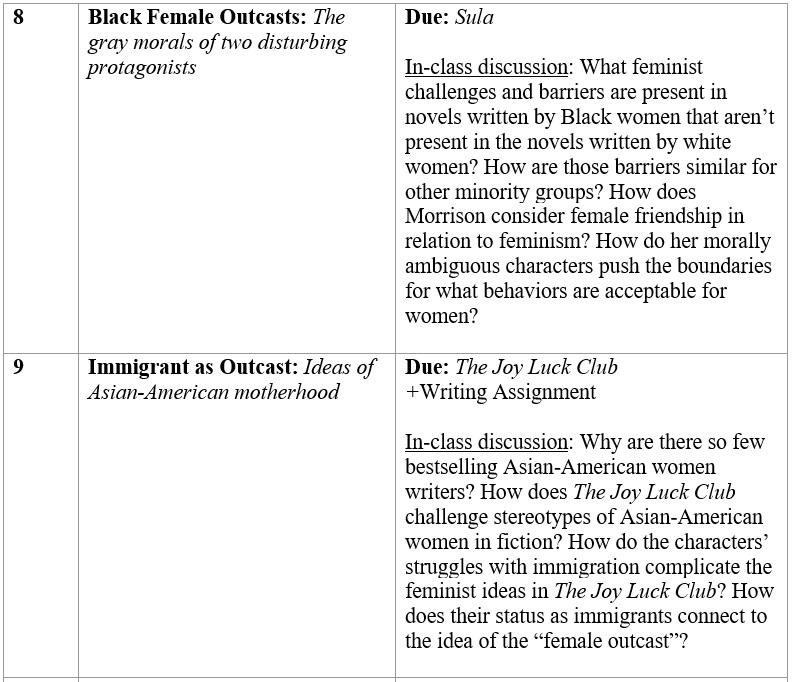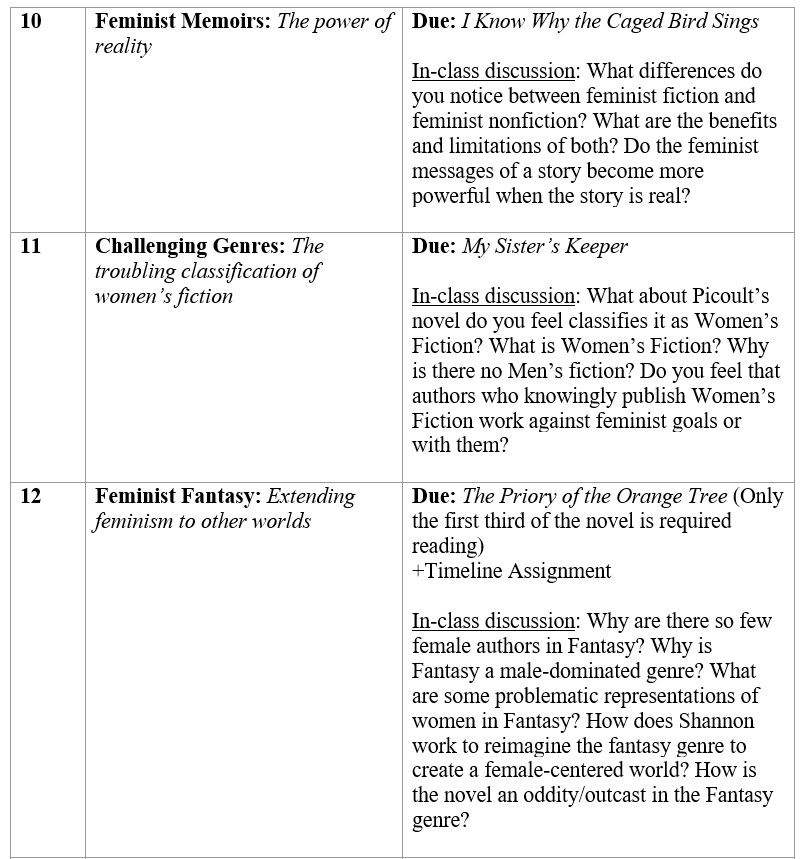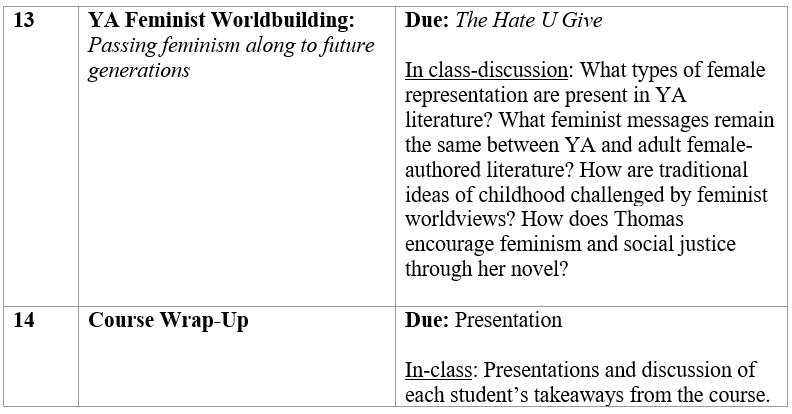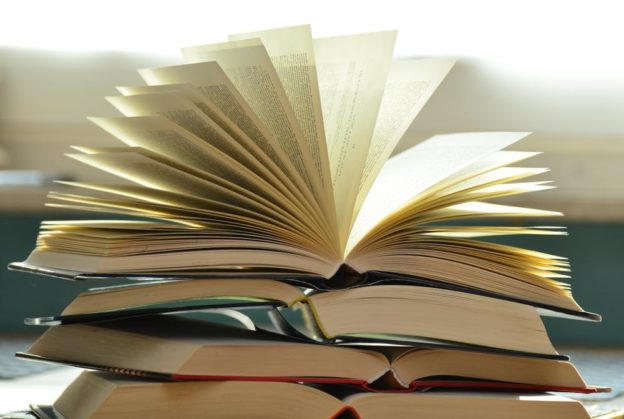If literature is meant to challenge students by presenting them with different worldviews, then how can secondary and postsecondary educators construct a syllabus that encourages students to consider the implications of those worldviews? How can we design a course that invites students to consider what specific authors or characters may be trying to highlight about society through their unique perspectives? For example, how might we ask students to think about the ways in which women writers and their “outcast” female characters have challenged patriarchal structures at different points in history?
As a future English teacher, I’m someone that believes in the potential of literature to act as a window into our society at different periods in time. Even though literature consists of fictional stories, those imaginary worlds were created by people who were very real. Therefore, analyzing how those authors chose to depict their fictional characters can help us to better understand the social barriers and ideologies that existed during the specific historical periods they lived in, and comparing several novels side by side can help illuminate how those social constructs have shifted over time. For women writers in particular, the barriers they address in their novels may range from a lack of respect for female authorship to suffocating gender roles, and everything in between.
However, just simply noticing changes in what is considered “acceptable” in society during different eras isn’t enough to gain a deep understanding of the nature of societal change. Change always has a catalyst, and it only occurs after something has pushed or challenged the social norms of the time. Historically, literature has been a haven for people who like to push and reimagine those boundaries—highlighting problematic aspects of society while offering a new vision for that society through the lives and actions of unorthodox fictional characters. For example, characters such as Maggie Tulliver from George Eliot’s novel, The Mill on The Floss, or Sula Peace from Toni Morrison’s novel, Sula, are often viewed as outcasts in their fictional world because they defy the beliefs and expectations of their society. They are “ahead of their time;” therefore, these untraditional characters invite readers to envision a future where their “outcast” ideologies might one day be accepted.
Female characters in literature have a history of challenging what it means to be an “acceptable” woman, and through observing these literary female outcasts across a variety of novels readers can gain a sense of how feminism has evolved over the years. After all, even though they may share similar feminist goals, feminism in Emma has a completely different meaning than it does in a modern YA novel such as The Hate U Give. By reading novels that span across different eras and genres, students can gain a sense of how feminist ideas shift and change as well as how female authors have used literature to make their voices heard through the struggles of their fictional characters. For example, what can we learn by comparing Emily Brontë’s struggle to be heard in a literary world run by Victorian men to Samantha Shannon’s desire to infiltrate a male-dominated genre in our modern world? Studying the female protagonists written by women allows us to think about questions such as: How are female authors using the challenges of literary female outcasts to imagine, and help create, a more equitable world? How are their own struggles reflected in the characters they write? What power structures might be working to suppress the voices of these authors? How do factors such as race, class, and education intersect with, and complicate, the feminist issues that these authors attempt to address?
A literature course would be a perfect space for students to attempt to answer these types of questions, so I’ve designed a mock course where each week students would be invited to think about female-authored texts from a different perspective, considering topics such as class, education, race, barriers to female authorship, intended audience, the impact of nonfiction, the boundaries of different literary forms and genres, and the power of different literary forms and genres in relation to feminism. Even though the course would address a wide range of topics related to feminism in literature, I feel that range is important to give students a more complete picture of the complex and intersecting issues that are often addressed by female authors. While I’ve designed the course for college students, it was only designed that way because I felt that a college syllabus would provide a better example of the number of diverse issues surrounding female-authored works—rather than a high school syllabus which, realistically, doesn’t have the time for an eleven-book unit on feminist literature. With the limitations placed on secondary ELA teachers by state standards and administrators, it would be rare to find a classroom that has the time and freedom to devote several months to studying feminist literature. However, that’s not to say this college syllabus can’t be used as a jumping off point for a unit on female-authored works in secondary classrooms. In fact, as an aspiring high school teacher myself, unit design was on my mind as I thought about the different discussion topics for this syllabus. I believe that a secondary teacher easily could choose a single week I’ve described on the syllabus, depending on which novel and discussion topics they feel would be most appropriate and beneficial for their specific classroom, and then design a unit around those questions. Even if high school students think about just one of these texts in relation to feminist issues, I believe it could be a beneficial exercise.
In terms of assignments for this potential college course, I decided to assign weekly blog posts so that all students would have the chance to share their opinion of the readings each week. Instead of creating a list of secondary literature to go along with the readings, there would be a designated student each week that would be responsible for bringing in an article for discussion. I feel that this allows for secondary readings to be included in the course, but in a way that is tailored to the specific interests of the class. The ideas for the mind map and timeline assignments that I’ve described in the syllabus were based on the belief that it would be helpful for students to visually see how all of the works and feminist concerns relate to each other. Lastly, I incorporated a traditional writing assignment so that students who benefit from using writing to think through their ideas would have a space to express themselves and what they’ve learned, and I added a final presentation because I wanted to give students the opportunity to introduce other works to the class that that they felt were important to the topics we discussed in class. My hope was that through the different texts, discussions, and assignments, students would gain a much better understanding of the development and implications of female-authored literature. And, while I tried to design the syllabus in a way that covered feminist topics that I personally felt were the most interesting and thought-provoking, it is not meant to be all-encompassing. I would encourage anyone who finds this syllabus helpful to modify it for their own classrooms by substituting in other novels or discussion questions that they feel are best suited for their own courses.
Feminist Worldmaking Through Female Outcasts: The Struggle of Women Writers to Rethink and Rebuild Patriarchal Societies
“Conventionality is not morality.” –Charlotte Brontë
In this course we will explore the literature of women writers to consider how they attempt to reimagine their own worlds through prose. We will read literature spanning over a hundred years to think about how the representation of women in literature, the public’s reaction to women writers, and the perceptions of a female’s place in society have changed throughout history. Through the assigned readings will attempt to answer questions such as: What barriers do female authors face as writers? How does the representation of female characters differ between novels written by men and novels written by women? What responsibility do female authors have to challenge patriarchal structures? To what extent are the “female outcasts” that continue to reappear as protagonists a way for female authors to reimagine a women’s place in society during their historical time period? By the end of the course, students should gain a better understanding of how literature has been used, and continues to be used, by female authors as a means of reshaping society into a more feminist and equitable world.
Required Texts:
1. Emma by Jane Austen
2. Mill on the Floss by George Eliot
3. Wuthering Heights by Emily Brontë
4. The Collected Poems of Emily Dickinson by Emily Dickinson
5. The Handmaid’s Tale by Margaret Atwood
6. Sula by Toni Morrison
7. The Joy Luck Club by Amy Tan
8. I Know Why the Caged Bird Sings by Maya Angelou
9. My Sister’s Keeper by Jodi Picoult
10. The Priory of the Orange Tree by Samantha Shannon
11. The Hate U Give by Angie Thomas
*In addition to the required texts, you must also be able to access the course website each week. I will e-mail everyone a link to the website at the beginning of the semester, along with instructions on how to register. This website is where you will write the weekly blog posts that are required for the class. Please let me know as soon as possible if you have any issues accessing or posting to the website.
Course Requirements:
Active Participation: 10%
Weekly Blog Posts: 20%
Discussion Article: 15%
Mind Map: 10%
Timeline: 10%
Writing Assignment: 15%
Presentation: 20%
Assignments:
Weekly Blog Posts: Every week I will post a question about the assigned reading on the course website. You are expected to post a response to that question (~400 words) by 12pm on the Tuesday before class. Before the start of class, you are also expected to respond to the ideas in at least one of your classmates’ posts (~200 words). We will use these responses to start our discussion each class.
Discussion Article: Each student will be assigned a week where they are responsible for choosing a reading that they feel is important for that specific class. I’ve listed some of the topics that will be discussed each week on the course schedule, so you must choose a reading that relates to at least one of the ideas for the assigned week. You may choose an article from an academic journal, a news article, an article from another blog or website, or even a video that you feel connects to the topic. You will be asked to provide your classmates with a section of the reading (if possible) and summarize its main ideas for the class. After you summarize the key points, you must talk for a couple of minutes about how it relates to the assigned text and the ideas we will be discussing that class. Discussion of your reading will then be opened up to the entire class.
Mind Map: You must pick at least two of the characters from the assigned texts and create a mind map that explores the connections between them. Your mind map should be complex and consider the different connections between the characteristics of the protagonists, their decisions, actions, relationships, personality, the barriers they face as women in their society, and how they push against those barriers. You may create your map digitally, or with art materials on a sheet of paper. However you choose to create it, your map should be visually appealing.
Timeline: Towards the end of the course you will be asked to think about how the different authors and works relate to each other on a “feminist timeline”. You should plot out the works and authors on a timeline, and then plot out how representation of female characters has changed over time, how the barriers experienced by female authors have changed, how the genres female authors write in has changed, and so forth. Your commentary should reflect some of the ideas and topics from our class discussions. I’m also asking you to extend your timeline past 2019 to imagine how these ideas might continue to change in the near or distant future. Your timeline can be created digitally or with art materials on a sheet of paper, but it should be visually appealing either way. Images and creativity are strongly encouraged.
Writing Assignment: You must write a 3 to 4-page (double-spaced) paper that considers the idea of the female outcast. Why are females who push boundaries portrayed as odd in literature? How were female authors perceived as odd in earlier time periods and pushed to the edges of society? How do you see the idea of the female outcast developed through the assigned texts? Please develop a thesis that addresses at least one of these questions and incorporates evidence from at least two of the assigned texts.
Presentation: During the last week of class you will be giving a presentation on a female-authored work of literature of your choice. I’m not asking you to read another text for this assignment (although you can if you want to), but rather asking you to choose a work you’ve read that wasn’t assigned for the class. Your presentation should be around 10 minutes long and should incorporate some type of visual element. In this presentation you shouldn’t summarize the work (although a brief summary will be necessary for those of us who haven’t read it), but should instead describe how the work (and/or the author of the work) relates to some of the ideas that we’ve discussed in class.
Schedule:
